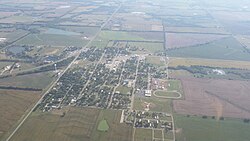2010 census
As of the census [14] of 2010, there were 746 people, 289 households, and 203 families residing in the city. The population density was 1,308.8 inhabitants per square mile (505.3/km2). There were 319 housing units at an average density of 559.6 per square mile (216.1/km2). The racial makeup of the city was 94.8% White, 2.0% Native American, 0.1% Asian, 0.5% from other races, and 2.5% from two or more races. Hispanic or Latino of any race were 3.1% of the population.
There were 289 households, of which 38.8% had children under the age of 18 living with them, 51.2% were married couples living together, 13.8% had a female householder with no husband present, 5.2% had a male householder with no wife present, and 29.8% were non-families. 26.3% of all households were made up of individuals, and 11.5% had someone living alone who was 65 years of age or older. The average household size was 2.58 and the average family size was 3.07.
The median age in the city was 31.7 years. 30.4% of residents were under the age of 18; 9.2% were between the ages of 18 and 24; 25.3% were from 25 to 44; 22.5% were from 45 to 64; and 12.5% were 65 years of age or older. The gender makeup of the city was 46.4% male and 53.6% female.
2000 census
As of the census [15] of 2000, there were 794 people, 302 households, and 221 families residing in the city. The population density was 1,645.7 inhabitants per square mile (635.4/km2). There were 322 housing units at an average density of 667.4 per square mile (257.7/km2). The racial makeup of the city was 96.73% White, 1.64% Native American, 0.25% Asian, 0.63% from other races, and 0.76% from two or more races. Hispanic or Latino of any race were 3.27% of the population.
There were 302 households, out of which 41.1% had children under the age of 18 living with them, 59.6% were married couples living together, 10.3% had a female householder with no husband present, and 26.8% were non-families. 24.2% of all households were made up of individuals, and 9.9% had someone living alone who was 65 years of age or older. The average household size was 2.63 and the average family size was 3.16.
In the city, the population was spread out, with 32.2% under the age of 18, 10.5% from 18 to 24, 27.7% from 25 to 44, 18.6% from 45 to 64, and 11.0% who were 65 years of age or older. The median age was 28 years. For every 100 females, there were 92.7 males. For every 100 females age 18 and over, there were 94.9 males.
The median income for a household in the city was $37,639, and the median income for a family was $42,981. Males had a median income of $34,750 versus $20,227 for females. The per capita income for the city was $16,202. About 4.8% of families and 5.8% of the population were below the poverty line, including 8.0% of those under age 18 and 8.0% of those age 65 or over.








